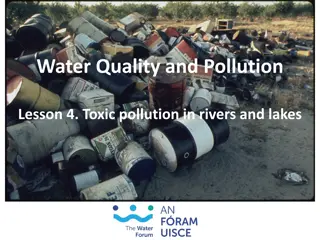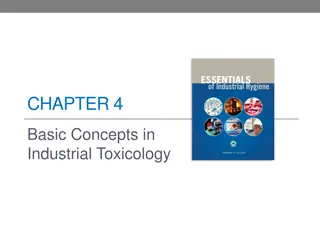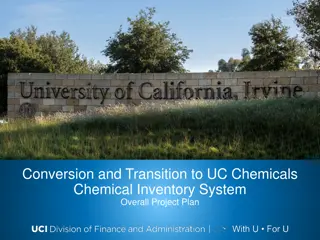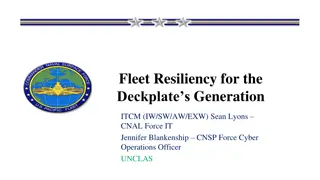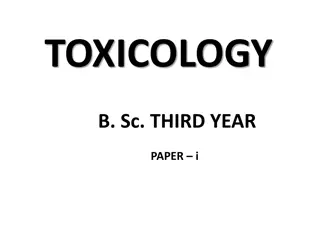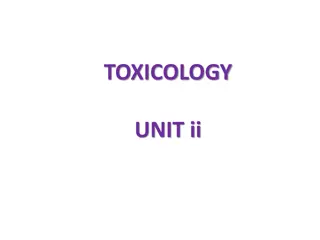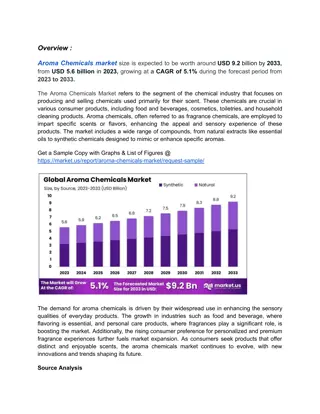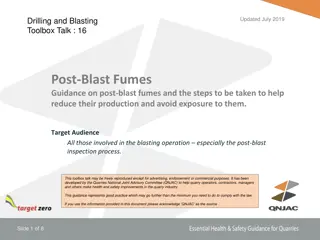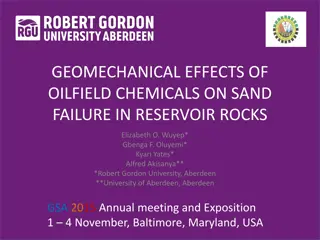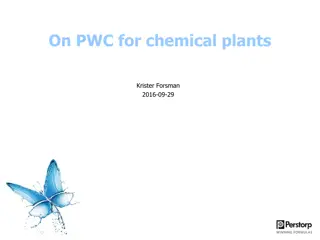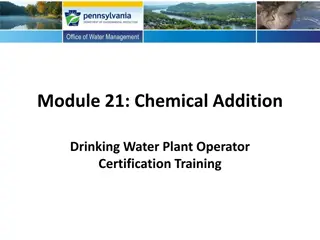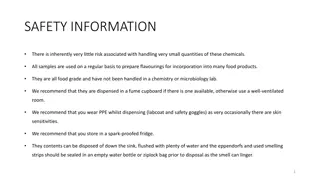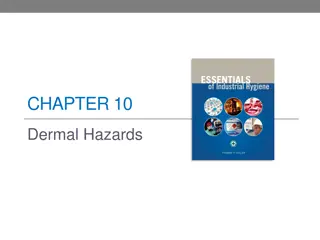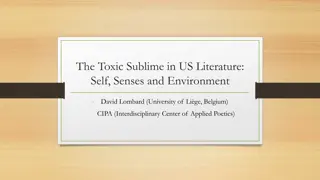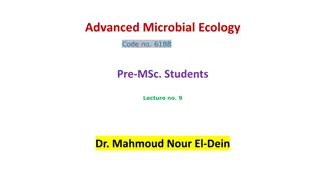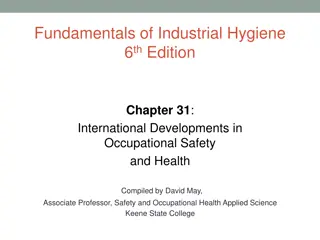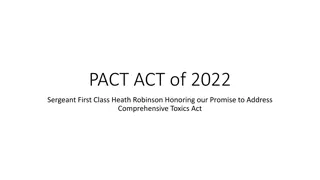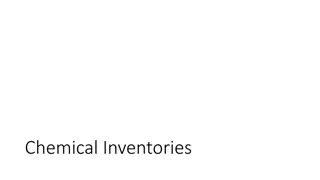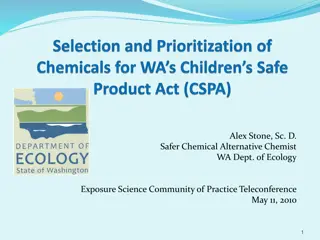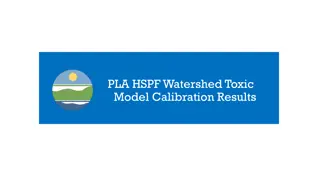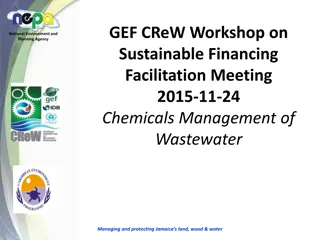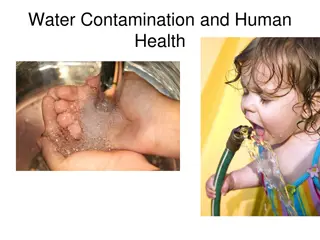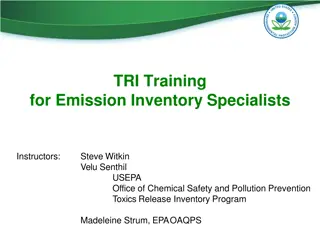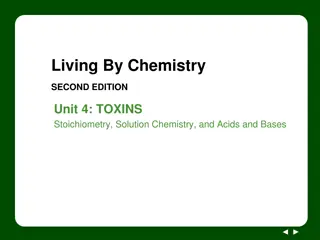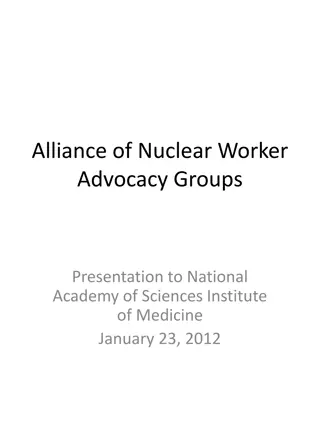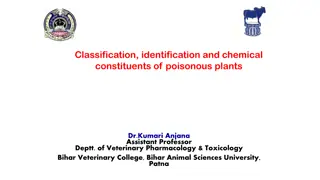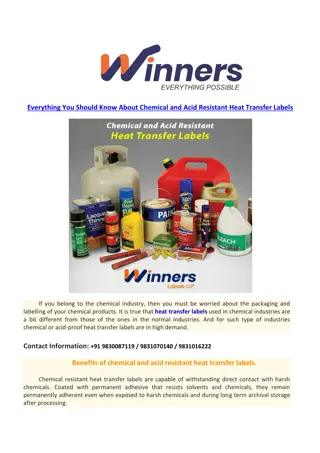Abrus precatorius
Abrus Precatorius, also known as the jequirity bean or rosary pea, is a highly toxic plant that is found throughout the tropics. Its seeds are used in jewelry and necklaces, but they can be fatal if ingested. This article explores the distribution, toxic principle, animals affected, mechanism of tox
18 views • 23 slides
Green Chemistry Chemicals Market Size Report, 2022-2029
The green chemicals market is expected to reach $217.18 billion by 2029 at a CAGR of 11.6% from 2022 to 2029. The growth of this market is driven by the scarcity of non-renewable resources, growing awareness regarding sustainable products, rising government initiatives to promote the use of green ch
2 views • 4 slides
Overview of Heavy Chemicals Manufacturing Process
The field of industrial chemistry involves the large-scale preparation of heavy chemicals, which are chemicals produced and used commercially. This process requires an understanding of various physico-chemical principles and specific manufacturing techniques for chemicals like Ammonia, Sulphuric Aci
1 views • 30 slides
Understanding Feminism, Sexism, and Toxic Masculinity - A Reflection on Gender Equality
Explore the concepts of feminism, sexism, and toxic masculinity through activities and discussions, challenging misconceptions and promoting gender equality. Reflect on learning and origins of misconceptions to foster a more inclusive society.
0 views • 7 slides
Understanding Toxic Pollution in Rivers and Lakes
Toxic pollution in rivers and lakes is a pressing environmental issue caused by various pollutants such as metals, pesticides, chemicals, and microbial contaminants. These pollutants can have detrimental effects on aquatic life, human water use, and health. Learn about the impact of toxic pollutants
2 views • 20 slides
Understanding Basic Concepts in Industrial Toxicology
Industrial toxicology is a vital field that studies the effects of various agents on organism health through mechanisms of action, toxicokinetics, and more. It explores toxic chemical absorption, distribution, metabolism, and elimination, as well as toxic effects on major organ systems. Learn about
0 views • 35 slides
Expansion of Health Care Eligibility for Toxic-Exposed Veterans
This Title expands the eligibility criteria for Toxic-Exposed Veterans in 38 U.S.C. 1710 by refining the definition of Vietnam-era herbicide-exposed veterans to include those who performed covered service in specified locations. It introduces three new categories of eligible veterans based on toxic
1 views • 19 slides
Streamlining Chemical Inventory Management with UC Chemicals
This project plan focuses on transitioning existing chemical inventories into UC Chemicals system to address challenges with outdated information and database discrepancies. The UC Chemicals application offers real-time updates, assists first responders, and simplifies inventory reconciliation using
0 views • 21 slides
Challenges and Solutions in Fleet Resiliency for the Deckplate's Generation
Fleet resiliency for the deckplate's generation faces training gaps, barriers, motivation battles, and toxic leadership issues. Lack of foundational skills and reliance on technical documentation hinder self-sufficiency. Toxic leadership and communication barriers impact motivation and retention. De
2 views • 9 slides
Urea Biosynthesis and the Krebs-Henseleit Cycle in the Liver
Urea is synthesized in the liver through a series of enzymatic steps known as the urea cycle or Krebs-Henseleit cycle. This process involves converting toxic ammonia into urea, a less toxic and water-soluble compound that can be easily excreted in urine. The liver plays a crucial role in urea biosyn
1 views • 20 slides
Understanding The PACT Act and Its Impact on Veterans
The PACT Act, named after Sgt. First Class Heath Robinson who succumbed to lung cancer from toxic exposure, is a law enhancing VA benefits for veterans exposed to harmful substances. It expands VA health care eligibility, ensures toxic exposure screenings, and mandates research studies on veteran he
0 views • 24 slides
Introduction to Toxicology: Science and Impact on Living Organisms
Toxicology is the study of adverse effects of chemicals on living organisms. It assesses probability of occurrence, quantitatively and qualitatively analyzing toxic effects. Toxicants are agents causing harmful responses in biological systems. Environmental toxicology focuses on pollutants' effects
0 views • 12 slides
Overview of Toxicology: Understanding Chemical Risks and Health Impacts
Toxicology is a crucial field that assesses the effects of various toxic substances on human health and the environment. From heavy metals to solvents, radiation, pesticides, and animal toxins, this discipline plays a vital role in identifying and managing risks associated with exposure to harmful c
0 views • 25 slides
Aroma Chemicals Market Expected to Soar with Surge in Organic and Natural Produc
Aroma Chemicals Market; By Source(Synthetic, Natural, Natural-Identical), By Products(Benzenoids, Terpenes and Terpenoids, Musk Chemicals, Others) (Ketones, Esters, Aldehydes), Application, Flavors, Convenience Foods, Confectionery, Dairy Products, B
0 views • 4 slides
Post-Blast Fumes: Guidance on Mitigating Toxic Gases in Drilling and Blasting Operations
Explosives used in blasting operations generate post-blast fumes, which can contain toxic gases like oxides of nitrogen (NOx) and carbon monoxide. This toolbox talk provides guidance on reducing fume production and avoiding exposure, with a focus on the physiological effects of different gas compone
0 views • 11 slides
Sanjivani Agencies - Supplier of Retail Pharma Chemicals in Hyderabad
Established in 2019, Sanjivani Agencies is a leading supplier and trader of Retail Pharma Chemicals in Hyderabad. They offer a wide range of products including animal feed, laboratory chemicals, glassware, plastic ware, and more. Committed to quality and customer satisfaction, Sanjivani Agencies aim
0 views • 7 slides
Geomechanical Effects of Oilfield Chemicals on Sand Failure in Reservoir Rocks
This study by Elizabeth O. Wuyep et al. explores the geomechanical effects of oilfield chemicals on sand failure in reservoir rocks. It discusses the role of oilfield chemicals, limitations of previous works, experimental flow chart, and static saturation tests. The research emphasizes the need for
0 views • 25 slides
Insights into Specialty Chemicals Industry: Perstorp Plantwide Control
Explore the intricacies of specialty chemicals plants through the lens of Perstorp's experience, covering topics such as control objectives, degrees of freedom, and characteristics of these complex facilities. Discover the unique challenges and considerations in controlling processes for specialty c
0 views • 38 slides
Chemical Addition in Drinking Water Treatment Plant Certification Training
Learn about the essential topics of chemical addition in water treatment, including the types of chemicals used, safety measures, dosage calculations, and feed systems. Explore the importance of coagulating chemicals and their role in promoting particle aggregation for effective water treatment. Dis
0 views • 133 slides
Food Grade Chemical Handling Safety Information
Handling food-grade chemicals for flavor preparation requires minimal risk with proper precautions. The chemicals include 2,3-Pentanedione and Vanillin, commonly used in food products. Safety measures such as using a fume cupboard, wearing PPE, and proper disposal methods are recommended to ensure s
0 views • 7 slides
Understanding Dermal Hazards: Anatomy, Toxic Absorption, and Health Effects
Explore the key anatomy and physiology of the skin, learn how toxic agents are absorbed, understand the adverse health effects of skin exposure to hazardous agents, discover methods of dermal exposure assessment, and develop controls to minimize skin exposure to dangerous substances.
0 views • 26 slides
Understanding Chemical and Biological Weapons Proliferation Risks
Exploring the risks associated with chemical and biological weapons proliferation, covering topics such as war scenarios, terrorism, dual-use issues, international conventions, and emerging threats. This includes discussions on the use of toxic chemicals in various settings, along with examples of p
0 views • 8 slides
Exploring the Toxic Sublime in US Literature
Investigating the aesthetic dimensions of Thoreau's environmental philosophy and its capacity to blur boundaries between natural and technological landscapes, David Lombard's research delves into the concept of the toxic sublime in literature. By redefining the sublime for the Anthropocene era, the
0 views • 10 slides
Understanding Heavy Metals and Their Impact on Organisms in the Environment
Heavy metals, such as zinc and copper, persist in the environment posing health risks to organisms. Industrial activities release toxic metals into water sources. Microorganisms can interact with heavy metal ions, altering their toxicity and resistance. Essential heavy metals are needed in small amo
0 views • 24 slides
Global Harmonized System of Classification and Labeling of Chemicals (GHS) Overview
The Global Harmonized System of Classification and Labeling of Chemicals (GHS) was developed to address the inconsistencies in hazard information for chemicals globally due to significant trade. The history, mandate, and provisions of GHS, along with additional domestic harmonization efforts, are di
0 views • 29 slides
PACT ACT of 2022: Addressing Comprehensive Toxics Exposure for Veterans
The PACT ACT of 2022, spearheaded by Sergeant First Class Heath Robinson, aims to address comprehensive toxics exposure issues for veterans. The bill includes provisions such as expanded healthcare, improved VA services, recognition of burn pit exposure, enhancement of compensation for Persian Gulf
0 views • 22 slides
If you are looking for Gel X in Los Altos Hill
If you are looking for Gel X in Los Altos Hill, 4hands Beauty is the first clean and non toxic nail salon in North Los Altos! We don't use acrylic and other harsh materials in our work, so there is no harmful evaporations and toxic smell in our salon
0 views • 6 slides
Building a Comprehensive Chemical Inventory System
Conduct a thorough review of all processes to identify and document all chemicals used on-site, create a standardized inventory with relevant information, and use the inventory to prioritize hazardous chemicals for substitution, track usage quantities, and streamline purchasing practices to prevent
0 views • 7 slides
Regulation of Chemicals in Children's Products for Safety
Massive safety concerns arose in 2007 due to high lead levels in toys, leading to legislation like the Children's Safe Product Act in WA. The Act restricted lead, cadmium, and phthalates in children's products, with a focus on Chemicals of High Concern to Children (CHCCs). The implementation involve
0 views • 27 slides
PLA HSPF Watershed Toxic Model Calibration Results Summary
This summary provides insights into the calibration results of the PLA HSPF Watershed Toxic Model. It includes information on the Green/Duwamish River sub-watersheds, estimated loads to LDW toxic load reach 604, and the statistical calibration targets for HSPF toxic simulations. The calibration sequ
0 views • 10 slides
Effects of Toxic Materials in Device Fabrication and Environmentally Friendly DSSC Options
Negative effects of toxic materials used in device fabrication processes include reproductive health issues, cancer risks, and respiratory abnormalities for workers. Dye Sensitized Solar Cells (DSSC) present a more cost-effective and simpler alternative to silicon solar cells, with metal sensitizers
0 views • 17 slides
Sustainable Management of Wastewater Chemicals in Jamaica
Wastewater management in Jamaica poses risks due to the use of chemicals that can harm public health and the environment. Proper treatment and disposal of wastewater chemicals are crucial to prevent long-term negative impacts. Addressing this issue requires a policy framework for sound chemical mana
0 views • 10 slides
Nuclear Receptor-Mediated Toxicity: Molecular Insights and Implications
TOXICOLOGY research on Nuclear Receptor-Mediated Toxicity by Prof. Zdeněk Dvořák delves into the evidence, molecular properties, structures, and signaling pathways of nuclear receptors such as Aryl Hydrocarbon Receptor (AhR). Detailed information on the impact of AhR-mediated toxicity, including
0 views • 19 slides
Water Contamination and Human Health: Causes, Types, and Examples
Water contamination poses a significant risk to human health, caused by various pollutants such as microorganisms, chemicals, industrial wastes, and sewage. Common sources include human and animal sewage, industrial emissions, pesticides, and agricultural runoff. Different types of contaminants incl
0 views • 25 slides
Understanding Toxics Release Inventory (TRI) Program
Toxics Release Inventory (TRI) program is a reporting system that tracks the waste management of toxic chemicals posing threats to human health and the environment. It was created in response to tragic incidents like the Bhopal disaster, aiming to provide information on toxic releases from industria
0 views • 26 slides
Understanding Toxicity: Mole-Mass Conversions in Chemistry
Explore the toxic nature of arsenic compounds and learn how to convert between moles and mass in this chemistry lesson. Understand the relationships between mass, moles, and the number of particles in a substance, and practice converting moles to mass and vice versa. Work in pairs to delve into the
0 views • 10 slides
Alliance of Nuclear Worker Advocacy Groups Presentation on Toxic Substances Exposure
Presentation by Alliance of Nuclear Worker Advocacy Groups addressing the need to develop a matrix of toxic substances and related diseases to facilitate timely compensation for DOE workers. Emphasizes the importance of thorough documentation and recognition of exposure risks. Discusses applicable l
0 views • 10 slides
Managing Toxic People in Your Organization
Understanding the three types of individuals - wise, foolish, and evil - can help you identify and handle toxic people effectively. Limit your interactions with foolish individuals, remove toxic people completely, and surround yourself with wise individuals to build a healthy organizational culture.
0 views • 8 slides
Overview of Poisonous Plants: Classification, Identification, and Toxic Chemical Constituents
This detailed chapter delves into the classification, identification, and chemical constituents of poisonous plants, shedding light on natural toxins, alkaloids, and toxic principles. It covers the role of alkaloids in plant toxicity, highlighting specific types such as piperidine alkaloids, pyrroli
0 views • 17 slides
Everything You Should Know About Chemical and Acid Resistant Heat Transfer Labels
Chemical resistant heat transfer labels are capable of withstanding direct contact with harsh chemicals. Coated with permanent adhesive that resists solvents and chemicals, they remain permanently adherent even when exposed to harsh chemicals and dur
0 views • 6 slides




